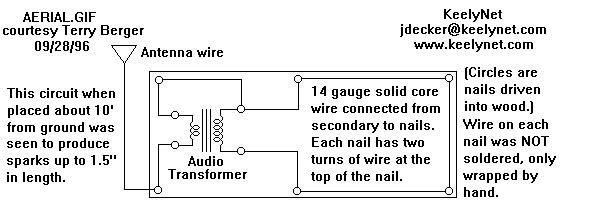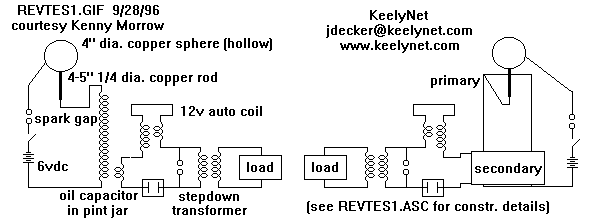
Aerial Power Tap Experiment
courtesy of Terry Berger
The following file is a most intriguing and fairly detailed account of phenomena associated with aerial electricity. It correlates quite nicely with many patents and earlier experiments where useable energy was claimed to be freely available from the air. Specifically, Perrigo, Britten, Moray and others too numerous to mention. Additionally, I have included a file courteously provided by Kenny Morrow where a Tesla coil secondary is used as a primary to intercept the high voltage and convert it to higher current, lower voltage. If you choose to experiment in this area, please share your findings with KeelyNet and other networks comprised of people interested in using such phenomena for practical ends. (and say thanks to Terry and Kenny for sharing this information with us all)
Date: Sat, 28 Sep 1996 01:34:01 -0600 / To: jdecker@keelynet.com
From: Terry Berger / Subject: Energy Device?
Hello: I'm sending the attached file to you for your examination. I do not know if I'm following the proper protocol for traffic to you or not, so if this is not the proper way to get messages to you - my appologies. If I have done everything right the file should be attached. The file is self explanatory. Thanks - Terry
Net and reading about 'Free Energy'
I was reminded of a childhood creation. I am sending this file to you in the hope that the device (I have called this gadget a 'device' simply because I do not have any better name for it) described below will prove of some usefulness to other readers, or at least serve as the 'curiosity' that I found it - and in retrospect, still find it to be.
As a kid playing with things electrical I built the following device in an attempt to boost the receive range of my crystal radio set. Please keep in mind that I am somewhat older than the nine years I was at the time and have recreated this entirely from memory.
The device was very simply constructed consisting of nothing more than the audio output transformer from an old radio, some solid single strand insulated 14 gauge wire (the kind used to wire houses), a few wood screws and 6" nails, and a piece of 1/2" pine board 14"x 8". The transformer had a non-center tapped 8 or 16 ohm secondary (I do not recall which).
I mounted the transformer on one end of the board and ran a wire from the secondary to the nearest nail down the length of the board to the next nail, to the next closest nail, down the board to the next nail and back to the transformer secondary. Or, in the diagram below, from S1 to N3, to N4, to N5, to N6, to the other transformer terminal (S2). The wire was wound twice around each nail near the top before moving on to the next nail. One primary wire was connected to a secondary terminal (N1 to S1). The other primary wire was attached to a piece of wire approx. 7' in length.
The transformer was covered with the bottom portion of a cardboard milk carton to protect it from the elements. This device was placed on the roof of our house near one eave and the long wire run down to my bedroom window. The board layout was as illustrated in the following crude diagram.
(I redrew the diagram in a .GIF to make it a bit clearer...>>> Jerry)

None of the connections were soldered, just twist type splices as my parents did not yet trust me with the soldering gun (something about branding my little brother).
This device did help with the crystal radio reception, probably because it was just a better antenna than I was using before. However, something very odd happened the first time a storm front moved through the area.
Electric arcs started appearing between the end of the wire and my window sill. The arcs ranged from 1/4" to 1.5" in length.
I could always tell when a storm was coming because the arcs would start appearing, reaching their peak during the storms highest intensity. The arcs would occur even when there were no storm clouds yet to be seen. I used to play with this electricity and received several very intense shocks from it. My parents finally made me take the device down.
I do not know if the following had anything to do with the operation of this device or not, but is included here for 'completeness' of the description.
The house was a rectangular one story brick home oriented long sides to the North-South, and had steel window frames. The roof had a pitch of no more than 35 degrees and was covered with standard asphalt shingles. The device was mounted no more than 10 vertical feet from the ground.
The transformer end was mounted closest to the edge of the roof and was oriented approx. toward the North. There were overhead power lines approx. 50' to the West which were the standard residential distribution main feeders, I would estimate of the 10KV to 15KV range. No transformers were in the immediate area. I made no attempt to measure the voltage generated by this device as I had no meter to do so. I do not know what the phase relationship between the primary and secondary windings of the audio transformer was, I didn't know such a thing even existed then.
The whole time I had this device on the roof it never occurred to me that with a few extra feet of wire - my brother was within easy reach. I was just too fascinated with the whole phenomena to be very malicious. With my current understanding of electronics I realize that it takes a considerable potential to produce arcs of 1.5", and this energy was free, although I do not know in how usable a form it may be.
I have not yet attempted to recreate this device, but intend to do so in the near future with various types of transformers. I will also attempt some properly documented experiments. If there is any interest in this device or this phenomena I will share the results.
This file is OK to reformat as needed and for release into the Public Domain if you consider it worthwhile, if not - I'm sure you know where the delete key is.
Terry Berger / Boise, Idaho / tberger@cyberhighway.net
Reverse Tesla Coil Tap
The following is part of an interesting packet of material courteously provided to KeelyNet by our friend Kenny Morrow of Pennsylvania. It correlates very closely with Terry Bergers experiment and claims to provide for a means of tapping useable quantities of energy by a 'reverse Tesla coil.'
Since I could not include all the construction details in the .GIF which follows, they are listed here as on Kenny's photocopy.
Normally, the primary is the input side of a transformer, however, in this concept, the secondary becomes the primary to be able to capture high voltage, low current discharges and convert them to low voltage, high current discharges.
The large coil (normally the secondary) is wound on an 8" diameter non- conducting form and is 2 feet in height. It consists of 640 turns (1,340.4 feet) of #24 solid core wire.
At the top of this large coil is a hollow copper sphere at least 4" in diameter. A solid copper rod of 1/4" diameter and 4-5" long is soldered or otherwise fastened to the bottom of the sphere. The sphere has a large surface area to collect aerial electricity. When the voltage reaches a high enough potential to bridge the spark gap, a current spike is inductively transferred to the smaller coil (normally the primary) where it is fed into a 12vdc automotive ignition coil.
The length of the copper rod which is connected to the base of the copper sphere, must be adjusted to 'tune' the device. The space between the copper sphere and the primary coil should also be adjustable for optimizing the energy collection. The primary coil is centered inside the secondary coil and the quarter-wavelength frequency is 9.84 megacycles.
Much like another fascinating patent (Britten - 1,826,727), the negative side of the battery is attached to the sphere, thus biasing it towards the collection of ambient energy because it served as an elevated ground (drain).
The fat coil (normally the primary which is serving as a secondary) is wrapped around the taller primary coil. It is constructed of 6 turns of 1/4" copper tubing (25 feet) on a 16" diameter drum, having 1.5" spacing between the turns. You can use cardboard tubes for the frame of the primary and secondary coils.
The oil-insulated capacitor is simply a pint jar filled with oil and having two or more metal plates held suspended and partially insulated by the oil. Note, the larger the surface area of the plates and the higher the dielectric of the oil, the more power can be extracted.

As you can see, the drawing is mirrored with the one to the right showing how the normal secondary would be inside the primary. The idea is to show not only the coil arrangement but how the sphere can be adjusted heightwise to allow for 'electrostatic tuning' for more energy accumulation.
Though I have not yet had a chance to experiment with these circuits, future posts will include any results or failure to achieve them by any of us at KeelyNet or whoever shares their tests with us. This kind of information needs to be as freely shared as possible to minimize patenting or other means of restricting its use. Please give these very simple experiments a shot and let us know what you find. Be careful, we are talking about several thousands of volts to produce a 1.5" spark. Thanks!